
Transcription
WATER REPORT
---------------
---------------
Concerns
----------
--------
December
--------
2016
------
------
INDEX
-------
--------
- Introduction (Page 2)
- History (Page 2-3)
- Water Treatment Plant (Page 3)
- Chemical Addition Possible Effects (Page 3)
- Additional Health Information (Page 3-4)
- Drinking Water Usage / Wastewater Treatment (Page 4)
- Operational Facts at MCI-Norfolk (Page 4)
- Facts in Dispute (Page 4)
- Summary / Requested Actions (Page 4-5)
- Resource List (Page 6)
Water Report
-------------
Concerns
----------
Introduction:
This review began in April of 2016 with a two prong focus, being water quality and water restrictions (usage). Various sources and agencies have supplied information in order to generate this report. Public records requests have been pursued and brought forth very telling information. This report is being written in an effort to obtain counsel and or assistance from outside sources to address the troubling water issues with MCI-Norfolk's water supply. Any referenced sources or data will include proper citations in the back of this report. Every effort is being made to make this report as brief as possible for the reader, and to provide factual information.
History:
1998 June: fuel oil was found to be seeping from a concrete floor (location is unclear). DEP, Emergency Response Team was notified and arrived on site. Water samples were taken and an outside consultant was mandated to work with the DOC, Division of Resource Management, and to take water samples monthly to ensure no contamination is/was present. (No information on those tests have been found).
2000: a "Total Coliform Bacteria" was found present in the drinking water. This resulted in a drinking water violation of ( 310 CMR 22.00 ). A notation was made "this may have been caused by "water hammer" in the distribution system and caused particles to loosen and flake off into the water mains.
2003: MCI-Norfolk Water Supply was found to have organic and inorganic contaminants at some prior time. Also in 2003 the frequency of testing was reduced because the last samples collected in March of 2003 were found to be free of contaminants by the DEP (Department of Environmental Protection).
2008 Augus: the Lifers' Group Inc. at MCI-Norfolk questioned the water quality at MCI-Norfolk. August 29, 2008 received a letter from the DEP, Drinking Water Program (Boston). In this letter the DEP indicated fuel oil testing indicated no VOCs had been detected (Fuel/Oil). Further it was noted that Well No:4 was in the process of being reconditioned, and Well No:2 was in use which had higher levels of iron thus causing "color in the water".
2008 September: MCLS (Prison Legal Services) was asked to help in having water testing from the tap within housing Units. (At the point of use). From the best knowledge and indications this has never been done.
2008 September: a Motion was filed with the Norfolk Inmate Council titled "Safe Drinking Water Issues". This Motion detailed many of the concerns detailed in this report.
2010: WES Construction Corp. noted on their web site, "WES is finishing construction of a New Waste Treatment Facility at MCI-Norfolk for the Division of Capital Asset Management".
2010: Litigation was filed in Suffolk Superior Court: Ten Persons Domiciled at MCI-Norfolk v. Department of Corrections, Docket No. SUCV-1--01813. This litigation included several affidavits of water conditions at MCI-Norfolk, letters of demand to both the DOC and DEP. The result of this litigation was an "Administrative Consent Order with Penalty and Notice of Noncompliance" File No. ACOP-CE-12-5D002, from the Commonwealth of Massachusetts Executive Office of Energy and Environmental Affairs, DEP (2014).
2011: The noted litigation AKA: 10 Persons, helped support the Norfolk Inmate Council's requests to have water filters installed within the housing Units starting 2011-2012. However the main litigant within the same action (10 Persons) who continued to seek enforcement of the Consent Order was abruptly transferred from MCI-Norfolk, without any of his property being transferred with him to include legal documentation.
2012: The New York Times wrote an article "Toxic Water": A series about the worsening water pollution in American waters and regulators' response. MCI-Norfolk/Ceder Junction Water Supply was noted as having been over legal and health limits.
2015: MassDEP once again found MassDOC in violation of "Air Pollution Control, Hazardous Waste and Underground Storage Tank" regulations. This violation was noted to be found in 2014 during an inspection of MCI-Norfolk by MassDEP. The MassDOC had failed to comply with the annual certification requirements of hazardous waste in which the DOC was fined and entered into another consent order to correct the violations. (Media Release, MassDEP)
2015 January 5: Massachusetts Department of Health noted during their "Facility Inspection-MCI-Norfolk" to include 425 repeat Health and Safety Violations.
Water Treatment Plant:
MCI-Norfolk / Ceder Junction Water Treatment plant provides drinking water for: MCI-Norfolk, MCI-Ceder Junction, Pondville Correctional Center, (currently closed), MCI-Baystate. This plant adds Sodium Hypochlorite to disinfect the drinking water to prevent waterborne diseases, also the treatment plant operates a Corrosion Control Facility which adds Potassium Hydroxide to raise pH and reduce the acidity of the drinking water to lessen the corrosion to the plumbing. In addition water usage numbers can be extracted from the "Chemical Addition Reports" on a daily, monthly, or yearly time frame.
Chemical Addition Possible Effects:
The Source of this information is the Center for Disease Control and Prevention (CDC).
[paragraph indent] Sodium Hypochlorite: Use, disinfection of water supply. Possible effects, labored breathing, shortness of breath, sore throat, Skin: burning, pain, blisters, Eyes: redness, pain. Effects may be delayed. Also attacks many metals. Long term exposure may cause skin sensitization.
Potassium Hydroxide: Use, to raise pH and reduce acidity of drinking water, lessen corrosion to plumbing. Corrosive, burning sensation to respiratory tract, sore throat, cough, labored breathing, shortness of breath, Skin: redness, pain, blisters, skin burns, Eyes: redness, pain, blurred vision, corrosive to both skin and eyes. Long term exposure may cause dermatitis and lung oedema.
[end paragraph indent] Additional Health Information:
Copper: is an essential nutrient but some people who drink water containing copper in excess of action levels over a relatively short period of time could experience gastrointestinal distress. In the long term, copper in excess could cause one to suffer liver or kidney damage.
Lead: in adults who drink water in excess of the action levels over many years could develop kidney problems or high blood pressure.
Drinking water, even bottled water, may reasonably contain small amounts of certain substances the EPA calls "contaminants". EPA Safe Drinking Water has regulations that set limits for this.
Drinking Water Usage / Wastewater Treatment:
MCI-Norfolk Water Supply covering 3 active prisons currently and for the past 12 plus months used 280,000-300,000 gallons of water a day. In 2016 June 2, the MassDOC requested and was granted a "Water Management Permit" (9P4-2-20-208.02) from DEP, Bureau of Water Resources for use of 490,000 a day (MGD). This permit also states, "...the Net Groundwater Depletion is less than 25% therefore minimization is not required." Additionally the MassDOC makes note within this same permit that MGD at 0.34 (340,000) for 2012, 2013, 2014. Also within a letter from MassDEP it states the Wastewater Treatment Plant is authorized to discharge up to 484,000 gpd. Hence water usage and waste are well below DEP standards and permits.
Operational Facts at MCI-Norfolk:
Hot water in the housing Units is brown until approx. 7:30 AM. The cold water is brown multiple times a week, and when the water is brown the Neads Dogs in training here at MCI-Norfolk receive bottled water given to their handlers. However the Human Inmates are told the brown water is fine. When Inmates are told not to drink or shower in the water, there is no drinking water provided. Weekly bottled water is purchased and delivered to MCI-Norfolk via the Supply Building. Housing Units are never tested fro water quality at the tap. The water filters advocated for are not changed within manufacturer standards and guidelines. Bottled water is sold to inmate population in 16 oz bottles for .65[cent symbol]. Inmates pay rate is average $2.00/day, thus inmates cannot afford bottled water. Water restrictions have been incerasing over many years, with a cause being that inmates are using too much water, and the wells are low. However, Drinking Water Usage and Wastewater Treatment does not reflect the same conclusions.
Facts in Dispute:
March 15, 2016 Administration at MCI-Norfolk noted during an Inmate Council meeting that they could not find a leak within the water system. However under Water Management Permit, leaks must be repaired within a designated period of time, or risk loss of permit. This leak, contrary to the permit (9P4-2-20-208.02) from DEP, rationale for water restriction, was the leak that could not be located October 27, 2015. The administration members at another Inmate Council Meeting noted water use was up. However once again this is not consistent with DEP Permit data supplied by MassDOC.
Summary / Requested Actions:
The water supply at MCI-Norfolk has been of cern for many years. Under the History of this report DEP and EPA has cited MCI-Norfolk for multiple violations to Health and Safety Standards since 1998. Attached is a list of men with health concerns at MCI-Norfolk in which one can conclude fall within chemical and Health concerns detailed in this report. When the water turns color (brown), the Neads Dogs are provided bottled water, but the human inmates are not. This creates a climate issue and concern with a strong distrust of the administrators' stance on any and all water/health related issues. With the factors detailed in this report the following is requested:
1) Establish reliable drinking water, safe within both health and legal limits and standards.
2) Provide enough water filters for housing units to function within manufacturer's guidelines.
3) Provide for testing of all housing Blocks water at the tap, from the 1st floor tho the 3rd floors. (approx. 24 samples) Via an independent contractor at different times in order to obtain an accurate sampling. (6:00 AM and 12:00 Midnight)
4) Place a corrective plan for replacing all pipes. Consider hiring skilled inmate plumbers to perform some of the work and defray the cost. Set a start and completion date for this corrective action plan.
5) Reduce the price of bottled water to come in line with DOC Inmate pay rates. Such as selling gallon jugs of water at fair prices.
6) Investigate medical concerns to determine if claims are valid and require medical attention. Once again this should be conducted by an independent contractor.
This report is compiled and submitted with a goal of real change to the drinking water crisis here at MCI-Norfolk. Corrective action will reduce medical issues and costs that are being contributed to by water deficiencies and violations.
Respectfully Submitted,
William Duclos
W48807 / MCI-Norfolk
2 Clark Street
P.O. Box 43
Norfolk MA 02056
** Any reports, letters or information referenced to in this report can be obtained by contacting either names persons on this report at the above address. **
RESOURCES LIST
---------------
- Centers for Disease Control and Prevention (CDC), 1600 Clifton Road, Atlanta GA, 30329
- Legal Advisory Committee, Norfolk Inmate Council, Massachusetts Correctional Institution at Norfolk, 2 Clark Street, P.O. Box 43, Norfolk MA 02056
- Massachusetts Department of Environmental Protection (DEP):
* Central REgional Office, 8 New Bond Street, Worcester MA 01606.
* Central Regional Office, Regional Director, 627, Main Street, Worcester MA. 01608
* Main Office, One Winter Street, Boston MA 02108, 617-292-5500
- Prison Legal Services (MCLS), 10 Winthrop Square 3rd Floor, Boston MA 02110.
- New York Times, New York New York
- MCI-Norfolk, P.O. Box 43, 2 Clark Street, Norfolk MA 02056
- WES Construction Corp.
===============================================
Health and Water Issues
----------------------------
------------------------------
Survey
---------
RESULTS
==========
December
-----------
2016
---------
MCI-Norfolk
P.O. Box 43
2 Clark Street
Norfolk MA 02056
SUMMARY
-------------
----------------
Health and Water Issues Survey
---------------------------------
December 2016
-----------------
Notes:
This survey was conducted by several members of the Inmate population and committees, and groups housed within MCI-Norfolk. All spelling was not changed in order to maintain the reporting.
Data Break Down:
-------------------
Total Number of respondents: 133
Skin Issues Reported: 86
Intestinal Issues: 61
Respiratory Issues: 12
Vision, Eye Problems: 5
** Some Housing Units failed to report, or turn in data as requested. This **
should not suggest there were no issues in those Housing Units. Additional data continues to to come in at the time of this summary.
Total Housing Units: 22
Total Units Responding: 14
Population of MCI-Norfolk: 1500 Approx.
Unit 1-1
Unit 1-2
Keith Ashby Face irritations
Tredana Purdy Dehydration
Darryl Scott Dry skin
Kion Beverly Skin dry and itchy
Derek Arruba Hairless, dry skin, skin irritation
Trent Linberg Skin issues, irritated skin
Jeffrey Britto Open soares on head, dry skin, sore throat
Stephen Huey Dehydrated, headaches, rash on neck, head
Unit 1-3
Clyd Bridges Dark Skin spots all over, rash, itching
Floyd Hamilton Liver Problems, Kidney Issues, disseness
Miles Miranda Breathing issues, skin problems
Eric Lowe Headaches, stomach issues
James Watson Bowel Issues, eye irritation
Eric Carpentino Gird, Diarhea, constipation
Unit 2-1
Michael Powe Cramps, pains from drinking water
David L. Robert Abdominal pain, dry skin
Paris Tillery Skin discoloration, exteremly dry
Phillip Llones Abdominal pain, dry skin
Francis Davis Abdominal pain, dry skin
Michael W. Lodge Sr. Discolored skin/eyes
Pedro Valentin Fungus feet, nails
Fernando Perez Stomach pain, dry skin
Roger L. Dew Patchy/dry skin, stomach pain
Michael Williams Dry skin
Jason Stiles Stomach pain, dry skin
Loius Rodriquez Skin/breathing problems
Leah Pinero Stomach pain, foggy vision
Jason Aquino Stomach problems, headaches
Hector Santiago Migrains, skin issues, stomach
Daniel L. Vandebogart Stomach cramps, diahrea
Jairin Perez
Anthony Davis Stomach aches, dry irritated throat
Erick Cournoyer Dry skin, stomach problems
Kevin Francis Stomach issues
Steven Sassone Stomach, diahrea, skin welts
Alex Somers Stomach issues
Edwin Rodriguez Stomach issues
Gregg M. Jenkins Jr. Stomach pain, dry skin, red spots
Jaime Berendson Stomach issues, dry skin, diahrea
Dwight Williams Stomach issues, dry skin
Adilson Neves Diahrea, dry skin
Abdullah R. Muhammad Intestinal disorders
Thomas Drouse Abdominal pain, rashes
David Little Abdominal pain, body rashes
Daniel Harrigan Dry skin
[illegible] McCourt Abodominal issues, skin rashes
Unit 2-2
Nom Sarout Dry skin, itchy
Jimmy Judgy Cancer
Kevin Podkowka Heartburn, itchy skin
John Marino Itchy skin
Callum Miller Skin issues, dry skin
Tony Mazza Stomach cramps, dry skin, rash
Louis Mathews Skin rash
Paul Robinson Urinary Tract infection
Geared Casey Skin cancer
Dave Parker Headache, fever
Wayne Parker Intestinal issues, dizziness, headaches
Tim Braley Chronic extreme, dandruff
Unit 2-3
Wayne Crosby Digestive, cough throat
Patrick Coelho Digestive
R. Leblanc G.I. condition
Robert D. Martinez Skin condition
Eric Pimental Skin conditions
Miles Otis - Hakeem Skin conditions
Tyrone Weaver Skin conditions
Thomas Declourette Skin condtitions
Unit 3-1
Unit 3-2
(Note: This unit only documented the number of inmates with conditions, not names.)
33 Clothing sent to the laundry. It is returning with the appearance of being stained, soiled, or worse, than when submitted.
02 With symptoms of G.E.R.D (heartburn etc...)
30 Men with fears about the quality of of water drink purchased bottled water or filtered water when available.
03 With cronic kidney stones
Unit 3-3
Unit 4-1
Brett Christian Skin discoloration, Kidney Bladder issues
Robert Murphy Rashes on skin, urinary track infection
Wayland Coleman Skin discoloration, stomach discomfort, pain in kidney and bladder areas, not feeling emptied during bowel movements
Unit 4-2
Mike Shrewsbury IBS/bloatin
William Sullo Irritable bowl syndrome, stomach aches
Michael Rosado Stomach problems
Carlos Baez headaches
William Squailia
Unit 4-3
Peter Chamerlin Nonhealing sores, perinem cysyt, swollen liver
Unit 6-1
Unit 6-2
Unit 6-3
Reginald Butler
Craig Smith Diagnosed with H. Pylori
Nicholas Traylor Skin rash
Luis F. Rivera Jr. Diagnosed with H. Pylori
Donald Ghee Skin rash
Raymond Leherich Skin rash twice
Unit 7-1
David Jones Itchy skin, sore throat
Jose A. Perez Itcy skin, headache and dizzyness
Porfirio Morales Itchy skin, sore throat, headache,
Corry Barry Red itchy patches on skin, dry skin
Anthony Harris Massive headaches, nausea, vomiting
Richard Feliciano Itchy skin after shower
Radoglaw Czerkawski Sore throat, itchy skin
Jared DeBarros Dry itchy skin wiht rashes
Ulpiano Pena Jr. Dry itchy skin with rashes, itchy scalp
Sean Walker Dry skin, rash on arms, bumps inner arm
Jose Raposo Afection on my throat
Martin Rodgers Headaches, cough, red eyes
Unit 7-1 (cont)
Clayton Enslow Psriosis
Michael Purcell Headache, skin
Jamal H. Spencer Irritation on skin, itchy skin
Claude Underwood Sore throat, dry skin
Steven Madison Dry skin
Justin Deprospo Nauseas, dry skin
George Powers Dry skin, hives
Chris Baker Dry skin, rashes, bumps
Donald White Dry skin, rash
Francis Sepulveda G.E.R.D. itchy skin
Lester James Diarhea, strep throat, coughing, dry skin
Lennin Abrow Skin rash and headaches
Steve Cavalcanti Dry skin pimles on back
Muhammad Sabin Extreme itchy dry skin, stomach aches.
Juan Figueroa Diarhea, stomach pains, itchy
John Stote Skin Cancer
Unit 7-2
Unit 7-3
Howard Lounsbury Chronic heartburn, bloches on skin
Emmanuel Williams Dry skin, stomach problems
Keith Richards Bloated and stomach pains
Chendara Vann Achne, skin irritations
Makentry Long Dry skin and scalp
Cajou Johnson Toenail fungus, blood in urine, skin blotch
Bryan Mayes Dry skin
Yuvar Perez Toe fungus, dry scalp
Richard Martinez Rashes, upset stomach, heartburn
Unit 8-1
Peter Hrycenko Skin rashes
Kenton Wright Skin pigment loss
M. Leaston Breakout on back
William Cook Breakout
Buddy Smith Breakout on sin, intetinal issues
David Ormonde Itchy skin
Tyon Feaster Dry skin, pigment loss, skin rashes
Salah Shakoor Teeth missing, skin irritation
David Kirpatrick Skin irritation
Abdullah Mahik Skin irritation
Eli Youn Skin irritation / eyes
Isaiah Dotson Skin irritation/rashes on body
The Conditioning And Counter-rehabilitative Process of Corrections
What does society really know about its corrections system? Is it OK for society to simply say, lock them up and forget about them, or should society be mindful of the consequences of such primitive thinking? What are the costs to our communities, when so many of the men in the community are incarcerated for egregious periods of time? Does nobody care? Or do they not know? Well, you be the judge.
The Department of Corrections' (herein after DOC) Vision Statement, Mission Statement, and Core Values states:
Vision = To effect positive behavioral change in order to eliminate: Violence, Victimization, Recidivism.
Mission = Promote public safety by managing offenders while providing care and appropriate programming in preparation for successful reentry into the community. Manage-Care-Program-Prepare.
Core Values = Responsible, Respectful, Hones, Caring (See Massachusetts Department of Correction, Strategic Plan 2013-2018, by, Commissioner Louis S. Spencer, Pg. 3).
When the public logs on to the DOC's web site and read things like this, they are undoubtedly left with the impression that the DOC is a positive and functional vehicle. The problem with this is, when the people of society are only equipped with information from the DOC, their knowledge and belief in the system is one-sided. The prison wall hides the other side of the story.
So what exactly is rehabilitiation? If the idea of rehabilitation is to change a person's thinking about his or her part in society, and promote positive behavior so that the released can become productive citizens, then the DOC is missing its mark. Persons, whom serve several years in an institution, are psychologically--as well as physically in some circumstances--conditioned by the rules and operations of the institution. So, how are your prisons conditioning the men and women who are housed in them?
Other posts by this author
|
2017 jun 24

|
2017 jun 24

|
2017 jun 24
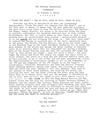
|
2017 jun 24
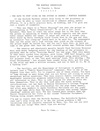
|
2017 jun 18
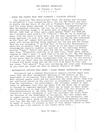
|
2017 jun 15
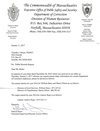
|
More... |
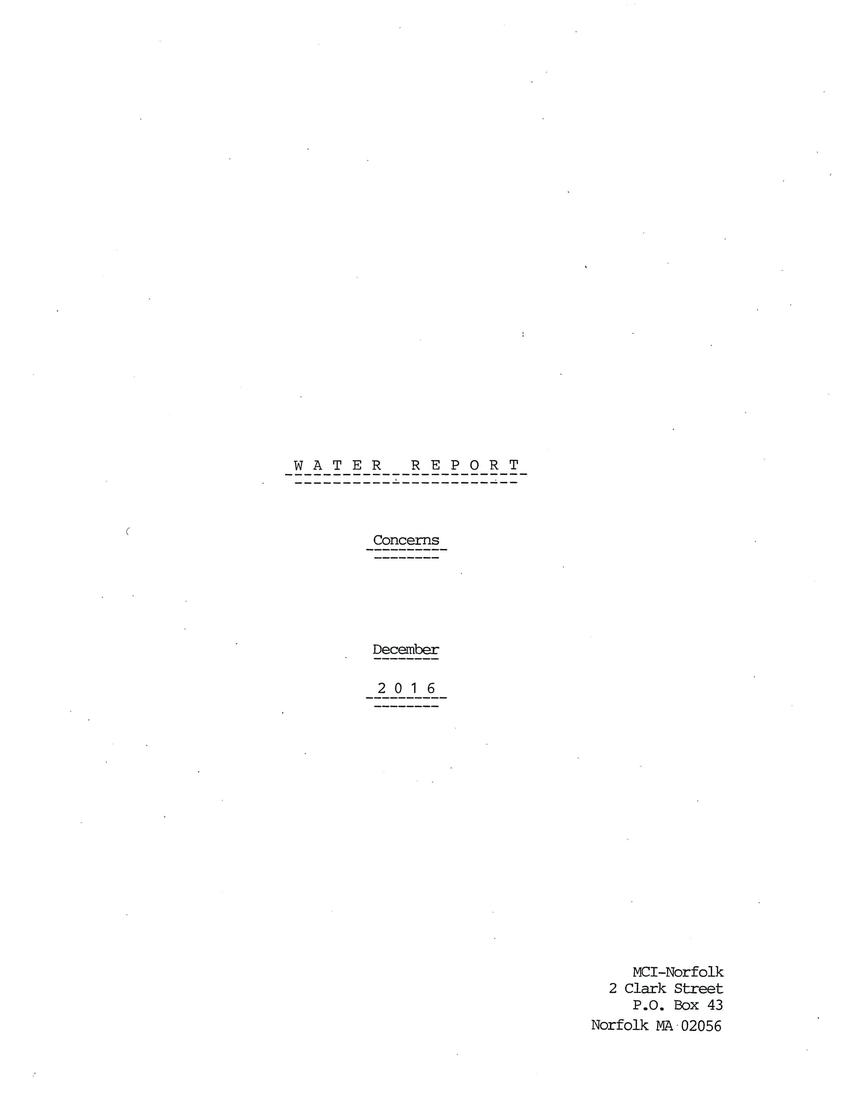
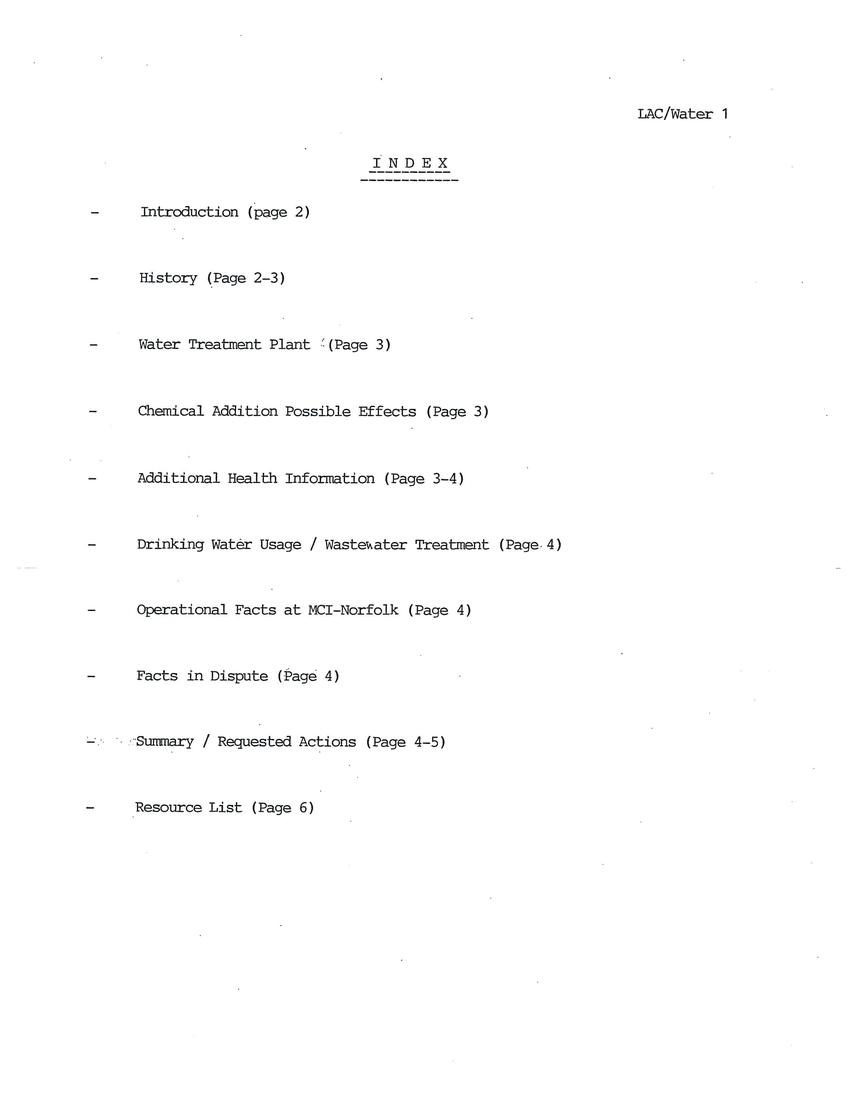
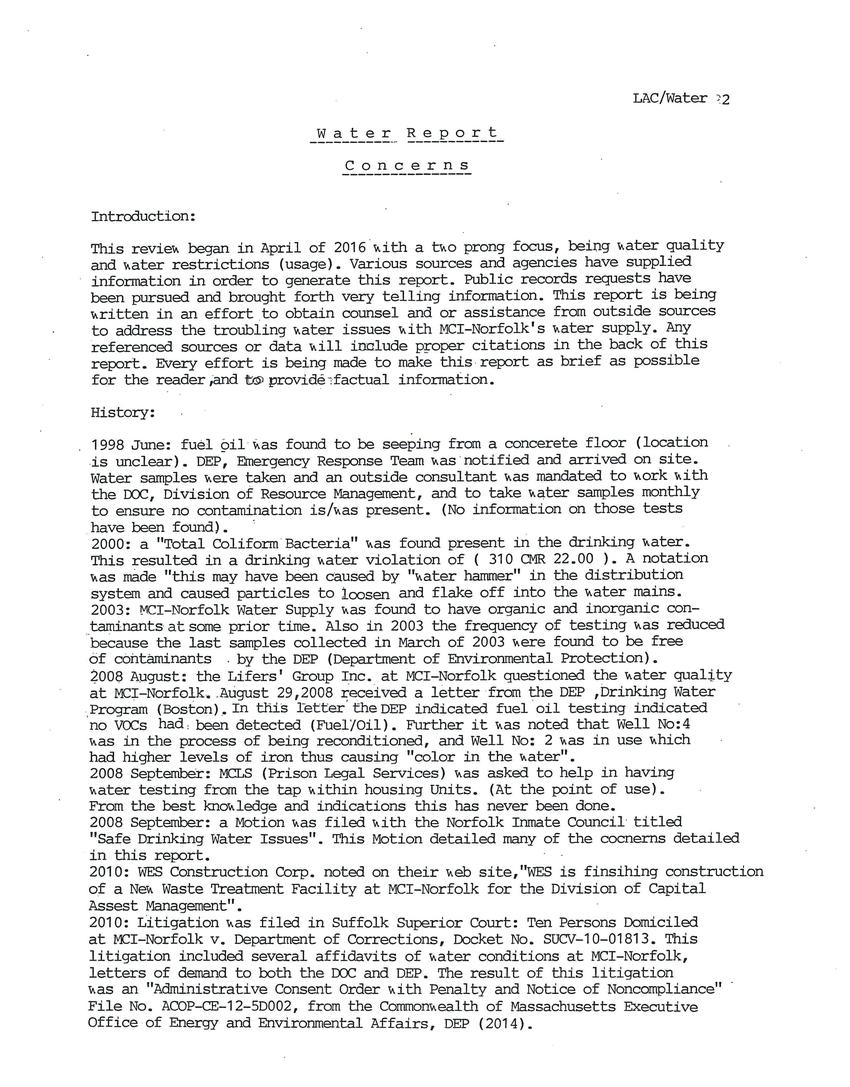
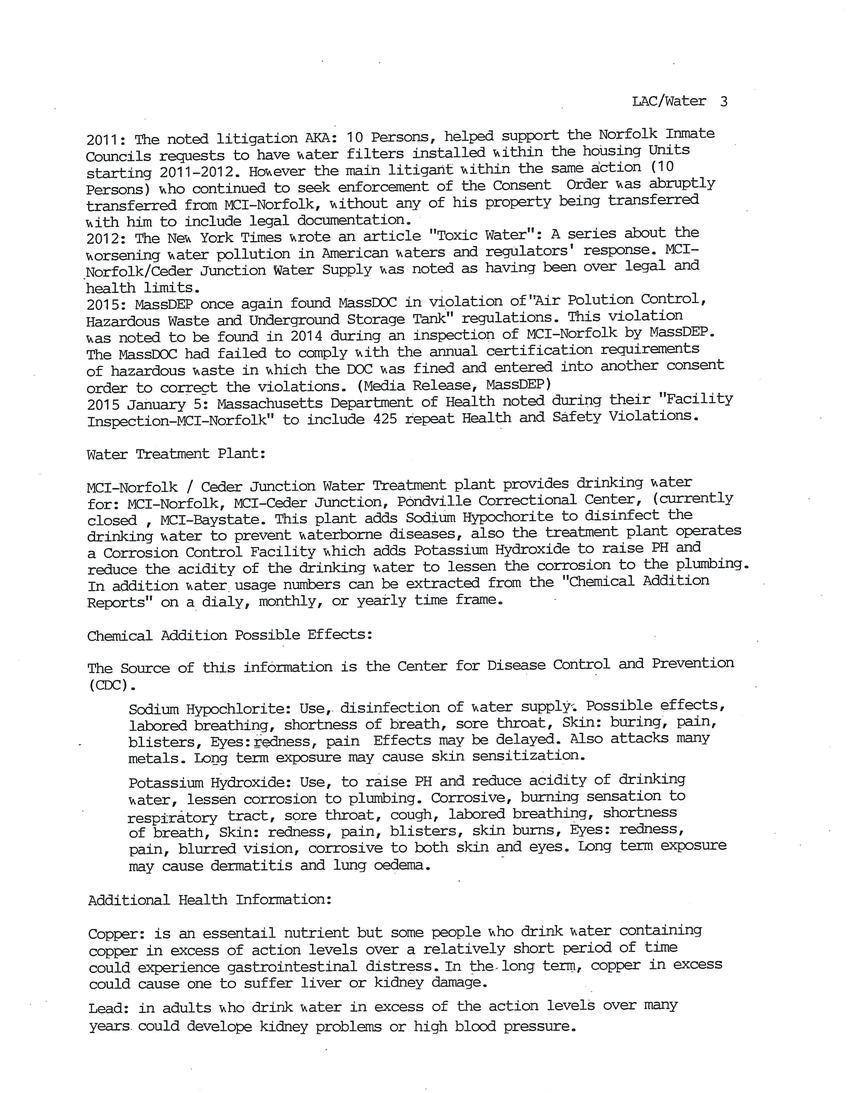
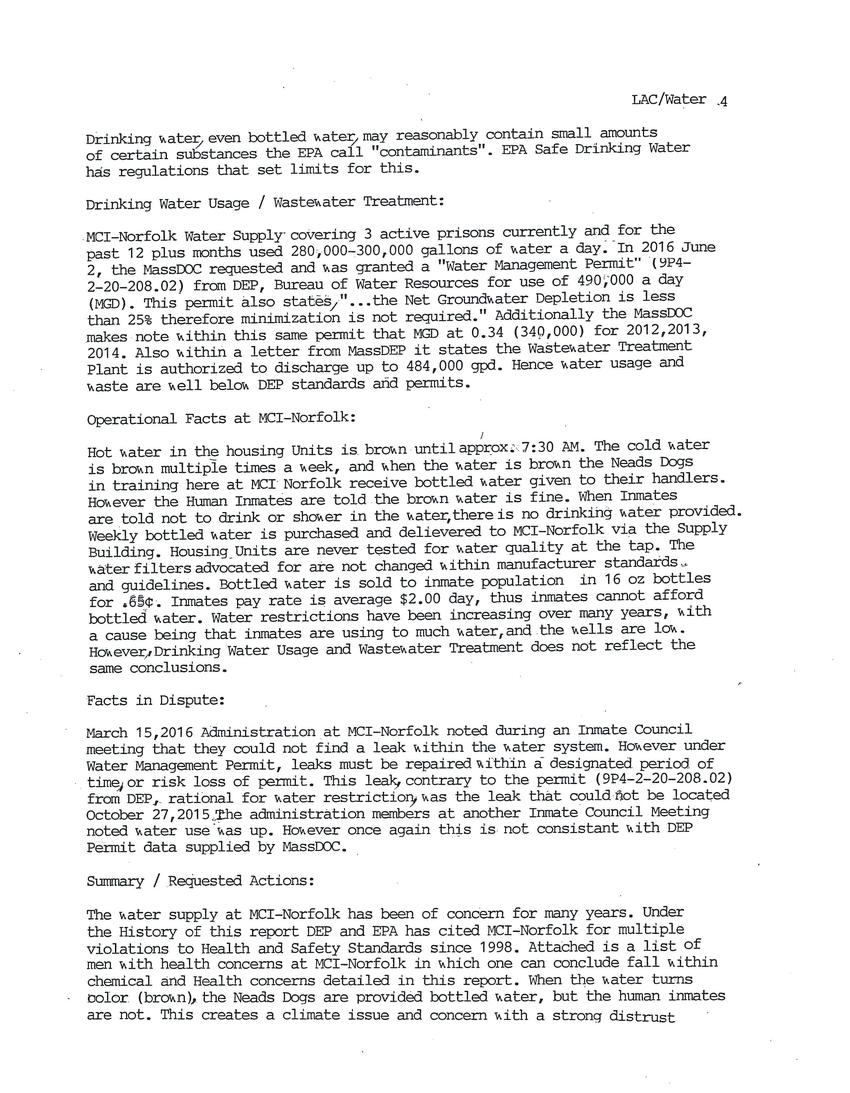
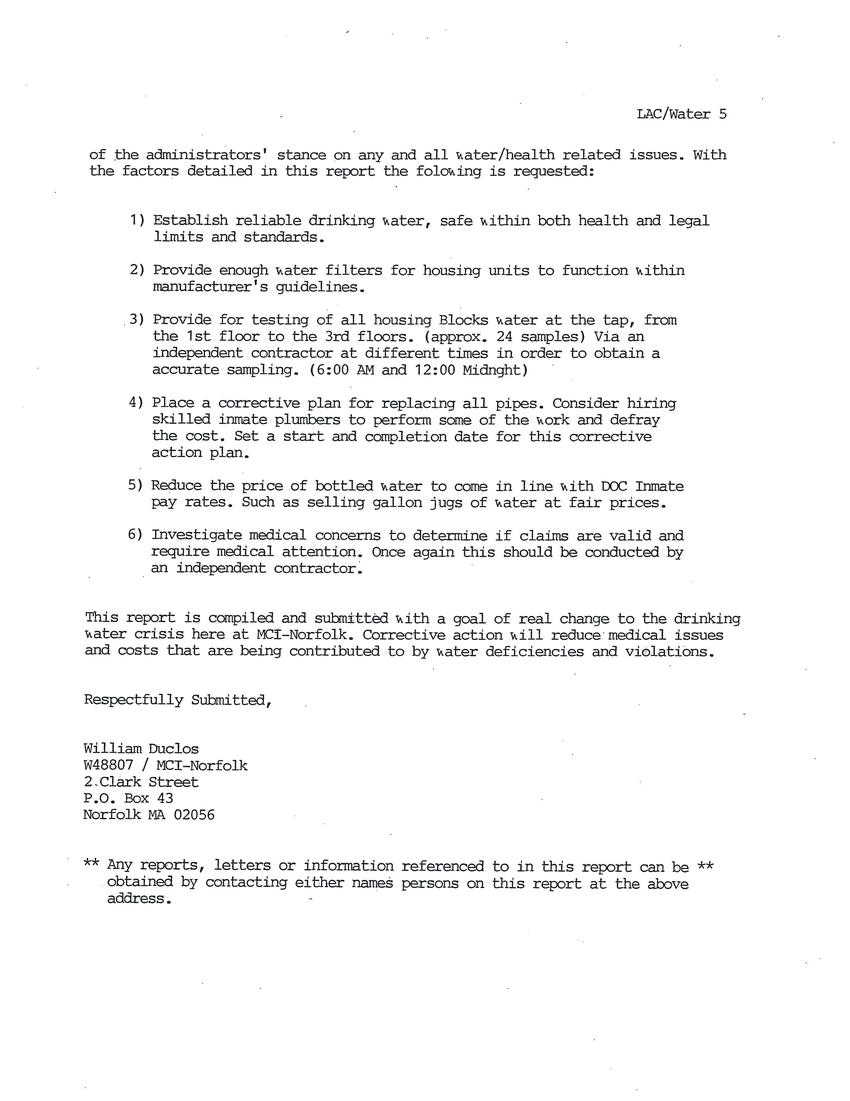

Replies (2)
For several decades PLN has reported on the intersections between mass imprisonment, the criminal justice system and the environment. Most specifically, the environmental destruction and degradation that prisons impose on surrounding communities – whether it entails building prisons in pristine environments like the High Sierra Mountains of California or the deserts of Arizona, or siting them on toxic waste dumps like the Rikers Island jail complex in New York City or on abandoned coal mines in Ohio and Pennsylvania. In those cases it is the prisoners and staff who are exposed to the consequences of long-running environmental disasters, such as contaminated water. The flip side of the criminal justice environmental disaster coin is that of the prison itself as a polluter. Past issues of PLN have reported how prisons across the country have been the sources of toxic waste contamination, mostly from sewage but also from hazardous chemicals and other pollutants.
The Human Rights Defense Center, which publishes PLN, has filed an environmental impact statement with the federal Bureau of Prisons over the negative impacts of building a maximum-security facility in an area of Appalachia that has severely contaminated water as a result of decades of coal mining, and which is the habitat of the endangered Indiana bat. HRDC has also filed a comment with the Environmental Protection Agency, requesting that they consider prisoners in environmental impact statements as part of the EPA’s environmental justice practices, which to date have specifically excluded prisoners. These initiatives are part of our new Prison Ecology Project, which seeks to put the issue of environmental justice as it relates to prisons and jails on the national map. We currently need to raise $50,000 to launch this project. If you can make a donation, please donate via postal mail, phone or our website, and note it is for the Prison Ecology Project. If you like this type of journalism and advocacy, you need to support it! The website for the project is: www.prisonecology.org.